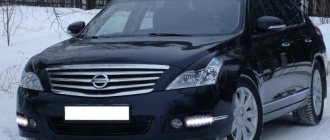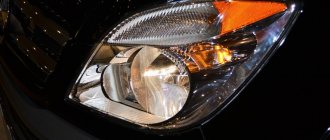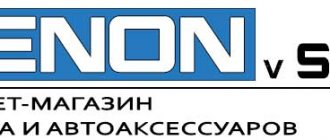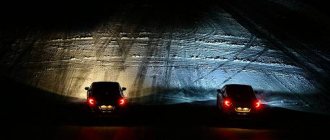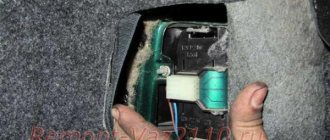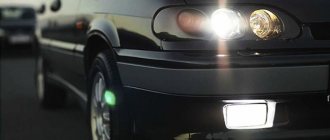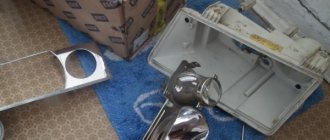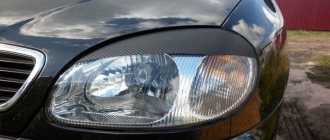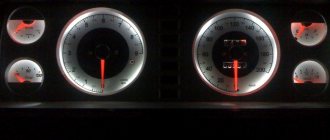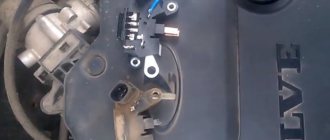There are many options for tuning a vehicle today. However, increasingly, in order to give their vehicle individuality, car owners are resorting to optics tuning. Some people install new headlights, others tint them, and others like DRLs (daytime running lights) made with their own hands from LEDs. You can learn more about the advantages and disadvantages of DRLs from this material.
Description of LED DRLs
Running lights are a type of optics used on the outside of a car body and designed to improve the visibility of the vehicle's dimensions. Today, the use of navigation lights is mandatory. In accordance with international EEC regulations No. 48, navigation light emitters must have an area of at least 25 and no more than 400 cm2. In addition, their aperture level should vary in the range of 400-800 Cd.
Criterias of choice
If you decide to purchase LED DRLs, then doing so today is quite simple, since this type of optics can be found in almost every car store. The main parameter that must be taken into account when purchasing is the aperture ratio, it is important that it is no more than 800 cd, not brighter. Such lighting will allow for good illumination of the road surface and at the same time prevent possible “dazzle” of oncoming drivers.
LED DRLs in cars
It should also be noted that LED running lights should be clearly visible from a distance of one hundred meters, no less. Otherwise, there is a risk of possible communication with the traffic police inspector. Another important parameter is that the upper edge of the running lights should be located above the edge of the low beam. After all, it is thanks to this that the visibility of the car on the road will be excellent.
Advantages and disadvantages
LEDs in daytime running lights have certain advantages:
- automatic activation;
- the vehicle becomes more visible on the road;
- The power of LEDs is quite high, while they consume significantly less energy;
- long service life, which should be at least 5 thousand hours;
- diodes do not affect fuel consumption in any way;
- The modern market offers customers a huge choice.
As for the disadvantages, the main disadvantage of such DRLs is the price, since it is not possible to buy high-quality running lights at a low cost. Installing high-quality LED DRLs that will have a long service life will require additional investment. Moreover, installation and purchase costs can be very high. However, in fact, such optics have excellent characteristics, so they pay for themselves quite quickly (the author of the video is Alexander Kordyukov).
Also, the disadvantages include the installation of daytime running lights in the absence of connectors. Of course, it is quite possible to solve such a problem, it will just take more time.
The best manufacturers and models
Now let’s briefly look at the main manufacturers of diode DRLs:
- First of all, I would like to highlight Osram DRL 101 - this model showed excellent ratings from users, in particular, for its original design. No one will be delighted with an LED strip, which cannot be said about light-filled tubes. The color temperature of the devices is 6000K, and each bulb can produce 400 lumens. The power of this model is 7.5 volts per unit.
- Hella ledayflex. Also quite a popular model, characterized by the presence of five diodes. The use of Hella ledayflex is allowed on absolutely any car. In addition, the consumer has the opportunity to configure the location of the diode elements. The color temperature in this case is the same, but the power is lower - 7.2 volts. The main qualities of Hella ledayflex are originality, as well as strength and reliability.
- Philips DayLight 4 LED12820WLEDX1. The cost of such devices is significantly lower than the options described above, most likely due to the design, because today no one can be surprised by the installation of traditional “boxes” with diodes. The power of one diode is 1 W, and the total power of the system will be only 8 volts. The only drawback of this option is the luminous intensity of 900 Cd; as we said earlier, the maximum luminous intensity allowed is 800 Cd (the author of the video is TheLadaGranta channel).
LEDs for Granta devices
The LEDs in the Granta DRL have high brightness. The current conductivity parameter is 4 μ. Experts are confident that the anti-phase interference system is of high quality. The sensitivity indicator in the device is 5 mV. Problems with LED overheating are extremely rare.
The light output of the model is 350 lm. The minimum permissible temperature for storing and operating LEDs is -25 degrees. The device is installed via a contact adapter. The output voltage of the LEDs is 10 V. The model’s filter is of the network type.
Replacement and installation instructions
If you decide to install diode running lights in your car, then you don’t have to go to the store for a new set, because you can do everything yourself. To make LED DRLs, you will need an LED strip. The LED elements themselves must be located on a special aluminum board, since they are not intended for manual installation, and accordingly, installation is unlikely to be without damage. Also, when purchasing, keep in mind that diodes from lesser-known manufacturers from Asia will most likely cost much less. However, the lighting from them will be many times worse, so we would recommend not saving, but giving preference to a more expensive, but higher quality option.
LEDs Osram 110
Ultra-bright Osram 110 LEDs are excellent for DRLs; they have high conductivity, which is why they are in demand. The decrease in sensitivity occurs gradually. The device is perfect for Ford and Honda brands. It is also important to note that the device is used in trigger models.
The output voltage parameter is 10 V. The filter for the LEDs is of the network type. The transceiver in this case is installed with an open conductor. The current overload reaches 5.8 A. Experts assure that the transceiver rarely overheats. The anti-pulse noise system is of the third class.
Video “Connecting diode DRLs in practice”
You can learn more about how diode DRLs are connected from the video below (author - channel 2673Kostya).
DRLs are an essential element of lighting in cars, which serves to identify the car and make it more expressive on the highway. Today, LED DRLs are used, which are environmentally friendly and economical.
They do not consume a lot of the car’s energy resources, do not affect engine overheating, last a long time, and have optimal brightness, which is immediately noticeable, and at the same time do not have the ability to blind drivers of oncoming or passing lanes. LED lamps are usually framed in a durable housing that is shock-resistant and does not allow dust, dirt or moisture to enter the housing.
The main task of the product
The main and main task of the lights is driver safety on the highway. Standard head optics do not have the brightness and light saturation that DRLs provide. In addition, often in the daytime, if the head low/high beam bulb (used as the same DRL) has burned out, you may not notice it. Accordingly, your car is no longer so expressive and catchy for others. If one bulb in the LED DRLs burns out, then this does not threaten you in any way, since often several light sources are used in separate devices for daytime driving. You can find out what characteristics you need to pay attention to when choosing daytime running lights in the article “Light characteristics of DRLs”.
Legal norms in Russia
In the period from 2010 to 2011, a law was passed in Russia that obliges driving in the daytime with active light - low/high beam, fog lights or separate devices called daytime running lights. Thanks to this, your car will be as catchy and noticeable as possible on the highway, and therefore safety is ensured. It is for this reason that today it has become important to install purchased DRLs, or make LED DRLs with your own hands.
Why is it recommended to install DRLs and not use low beams: the main differences
Many drivers are interested in the question of whether it is necessary to install separate DRLs on the car, or whether it is possible to use low/high beam headlights. It is still recommended to install separate DRLs, since they have a number of advantages over low beams:
|
These are the main advantages of DRLs, but if you do not want to buy expensive high-quality devices, then you can make daytime running lights yourself. With the right approach and the correct installation scheme, automatically turning on the DRLs yourself will be a useful function of the product. But, before making DRL with your own hands, you need to know the basic norms and requirements prescribed by law.
UNECE DRL Regulations No. 48/No. 87
If you nevertheless decide to install DRLs with separate devices on your car, regardless of whether you purchase them or make the DRLs yourself, you need to know the rules and requirements. UNECE Regulation No. 48 concerns installation, placement, number of devices, correct legal connection diagram and features of the functioning of the product. What to pay attention to first:
- DRLs must be installed in the amount of two pieces, and installation on a trailer is prohibited.
- You choose the installation diagram yourself.
- There are basic rules that limit you in terms of installing DRLs relative to the level from the road, from the edges of the visible surface. Such rules are necessary so that, ultimately, the light emitted from homemade running lights or purchased ones does not reflect and interfere with oncoming drivers.*
- The DRL connection diagram must be designed in such a way as to ensure their automatic activation in the desired situation.
What is LED
Pros of LEDs
Cons of LEDs
Now we have reached the most difficult stage, here you need to show ability and endurance, then everything will work out. In total, we can highlight the following options for connecting a flexible LED strip with your own hands to automotive electricity.
Connection using a block
The LED strip for headlights is connected quite simply in this way. In this case, the connection occurs directly from the battery, this allows the tape to remain independent from all the car’s electricity. The functions with this connection are similar to daytime running lights, the principle of operation of the unit is similar.
In this case, you can use a controller for a car LED strip, so you can independently regulate the frequency of the glow; if the strip is multi-colored, you can select the required color. Using the controller you can create modern lighting that is unlikely to be found anywhere else. However, you must understand that the controller costs money, and a lot of it.
Parallel connection
To carry out such an installation, you need to completely disassemble the headlight, while paying attention, the tape should shine outward. If it shines in the wrong direction, such illumination will be of no use.
Useful tips Connection diagrams Principles of operation of devices Main concepts Meters from Energomer Precautions Incandescent lamps Video instructions for the master Testing with a multimeter
How to choose daytime running lights
Until recently, drivers turned on low beam headlights to attract attention to the car. The use of daytime running lights eliminates some of the disadvantages that appear when using standard optics in the daytime.
- DRLs increase the service life of headlight bulbs. Frequently turning the low beam on and off negatively affects the life of the bulbs. This is especially true for lighting devices with improved luminous efficiency, such as +30%, +50%, etc.
- When using DRLs, the inclusion of side lights and license plate illumination is excluded. This allows you to reduce energy consumption and not impair the readability of brake lights.
- The presence of automatic activation of DRLs allows you to combat the car owner’s forgetfulness. Without turning on the standard optics during the day, a motorist risks getting a fine. And if you leave the headlights on low beam with the engine off, the battery will quickly drain.
Before you start connecting daytime running lights, you should consider a number of factors that influence the choice of DRL model.
Firstly, a lot depends on the installation location and car design:
- Additional optics can be rectangular or round. Here the design of the bumper and the appearance of the “front” of the car will play a decisive role.
- The size of the lights is determined by the niche that is in the bumper or air intake of the car.
- The brightness of each block depends on the number of LEDs. It should be between 150-330 lumens.
The second important factor when choosing daytime running lights will be compliance with regulatory requirements. During installation, several basic characteristics must be met:
- The height from the ground level to the lanterns should be in the range from 250 to 1500 mm.
- The distance from the extreme side point of the car to the headlight should not exceed 400 mm.
- The minimum distance between two DRL lamps is 600 mm. For vehicles up to 1300 mm wide, this parameter is reduced to a distance of 400 mm.
- It is also necessary to observe certain geometric parameters when installing DRL lights. The horizontal deviation should be 20 degrees in and out, and the vertical angle should be 10 degrees down and up.
A little history.
The first Niva was released in the late 70s. Despite its breakthrough design for those years, the Niva inherited optical instruments from the VAZ 2101, and if we delve deeper into the roots, we will come to the first electric headlights!
A headlight with a diameter of 7 inches with a lamp with two incandescent filaments was patented by Bosh in 1919. Of course, it was somewhat modified, but its mountings remained unchanged.
Here is an example of 7-inch headlights on a Willys (one of the first jeeps):
And today, standard 7-inch headlights are still used in the automotive industry... it doesn’t matter whether it’s a tribute to fashion, marketing or a whim...
Here is an example of such headlights on a Jeep Wrangler :
All this opens up vast possibilities for us to improve the light of our favorite SUVs. Of course, you could just replace the headlight bulbs with LED ones (and risk your license). But it is much more correct to install modern LED optics because it does not require any modifications, everything is installed with a bolt!
Expert opinion
It-Technology, Electrical power and electronics specialist
Ask questions to the “Specialist for modernization of energy generation systems”
Adjustment. but because of them, the person driving behind may not notice the brake light. If on a car you can confuse the stops and dimensions, it is the wrong car. Ask, I'm in touch!
Installation methods and connection diagram for daytime running lights
Installation of daytime running lights can be done in different ways, it all depends on the skills of the car owner.
When purchasing daytime running lights, please note that the kit must include two lights, connecting wires, installation materials and installation and operating instructions. In this case, the car owner will not have to rack his brains and look for DRL connection diagrams.
- For people who are afraid or do not want to engage in car maintenance or repair, it is preferable to contact a specialized car service center. An experienced auto electrician will quickly and efficiently handle the DRL connection.
- Those who are able to perform simple car tuning operations can be advised to buy a ready-made set of running lights. For example, Philips and Hella DRLs performed well.
- Fans of soldering irons and electrical circuits can completely make LED lights with their own hands and connect them.
The running lights can be connected using different electrical circuits (the simplest circuit is through a relay and oil pressure sensor). The main thing is that the DRLs turn on after starting the engine and go out when the low and high beam headlights are turned on. It is convenient to use a DRL controller for connection (a wiring diagram will also be provided for it).
It couldn't be simpler
This is the simplest scheme, which involves connecting to a battery or generator as a power source.
The scheme provides that the DRLs will be activated simultaneously with the engine starting. The point is to connect the plus to the positive terminal from the ignition switch of your Renault Logan or the same Lada Largus, and fix the minus on the car body in any convenient place. Everything looks simple and extremely logical. But you should not rush to conclusions, nor should you make such a connection. After all, it has an obvious drawback.
If the system is assembled according to this scheme, the diodes from the DRLs will start working constantly while the key is in the ignition switch. There is no question of any coordination with other headlights here. Therefore, such a connection contradicts GOST and traffic regulations.
How to make daytime running lights with your own hands
To make your own DRLs, you usually use cheap fog lights, LED strip, aluminum plates, silicone sealant and a soldering iron. The assembly sequence will be approximately as follows:
- First, the old fog lamp is disassembled and the internal filling is removed.
- Next, an aluminum plate is cut to the size of the flashlight body.
- A piece (or 2 pieces) of LED strip is cut to the size of the plate.
- An adhesive-sealant is applied to the degreased aluminum surface, and the LEDs are attached.
- All that remains is to use a soldering iron to connect the pieces of luminous tape and the electrical wire in series.
- The headlight is already assembled with a new filling.
To connect such DRLs, select one of the circuits suitable for a given car (it is better to connect via a DRL controller or via a relay and oil pressure sensor, as in the video below).
Installing daytime running lights on a car with your own hands becomes not only an interesting pastime. The result of the work will be a reason for pride for the car owner, because he managed to create a new image for his iron horse on his own.
Low beam or dimensions
You can also connect to the side lights or low beam headlights. In theory, everything here also looks quite simple, interesting and promising. The first of the schemes under consideration provides that you will use an electrical circuit that powers the size lamps. Here the plus from the DRL is connected directly to the battery as a power source. But the minus goes to the plus of the dimensions. At such a moment the latter will be electrically neutral. Thus, the current flows from the plus of the battery through the diodes to the dimensions, and then through the lamp to the housing, where the latter acts as a minus of the created electrical circuit.
Since the level of current consumption will be small, the diodes will start to work, but the size lamp will not turn on.
As soon as the driver switches to the dimensions, a voltage of 12V will appear on its positive side, the potentials will be equalized on the DRL wiring and the diodes will go out. The circuit will begin to operate in normal mode, supplying current to the dimensions.
Everything seems to be fine. But again, conclusions were drawn hastily.
The scheme is simple and working. It just has a few drawbacks:
- The drive trains will remain active when the engine is switched off. This directly contradicts current laws;
- If the dimensions are equipped with LED lamps, such a circuit will immediately become inoperative;
- Operation will not be correct when using powerful SMD diodes as part of DRLs;
- To provide additional safety, you will have to add a fuse to the circuit.
To avoid the first drawback, the circuit is slightly altered. The positive from the LED module is taken not from the positive of the battery, but through the positive of the ignition switch.
The second scheme involves activating the DRL using a low beam lamp. The point is that when the low beam is turned on, the walkers are turned off, and the rest of the time they work.
There are the same disadvantages here as for the previous scheme. That is, it contradicts GOST and traffic rules.
External design of the headlight
After installation has been done inside the headlight, it must be decorated. This is said very roughly; in fact, the design consists of one action - filling the insides with epoxy resin. It will securely fix all electrical wires inside the headlight housing, therefore, the likelihood that contact will be lost after some time is completely excluded. You also achieve a very high degree of tightness - resin is an ideal material for waterproofing. This means that water will not get inside when driving in rainy weather.
Please note that you will need to remove two wires from the housing, which you will subsequently connect to the car's electrical wiring. But it’s not even worth making DRLs from the main beam with your own hands - after all, the main design requirement - low energy consumption - will not be met. And the power of the high beam lamps is at least 100 W (and there are two of them in the car).
From the point of view of traffic rules
Clause 19.6. reads: “The fog lights turn on when the side lights are on, regardless of whether the high beam and (or) low beam headlights are on.”
First you need to understand what a fog light is in general. This is an additional light source that produces a flat and wide horizontal beam that extends directly above the road. Any deviation from this (let’s say it shines with a directed beam) turns the PTF into an additional light headlight, which, by the way, is installed on this Niva. The installation of additional headlights on the Niva is permitted by the manufacturer.
Rules
How to make angel eyes headlights with your own hands
Do-it-yourself installation of DRLs in standard headlights has some features. First of all, there are legal peculiarities of this revision. According to technical regulations, only lighting devices designed for this model can be installed on a car. For unauthorized installation of non-standard lighting devices, you can receive a substantial fine, as well as confiscation of illegally installed devices. In addition to DRLs, this includes underbody lighting and an equalizer. According to the rules, to install such equipment, the following steps should be taken:
- Contact the local traffic police, they should issue you a certificate of permission to install additional lighting equipment. It will indicate the type of devices allowed for installation on your car;
- Modernization work is carried out in a certified service center. As a result, you will receive a certificate of compliance with DRL standards;
- You go to the traffic police and record the changes.
